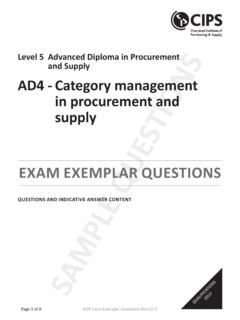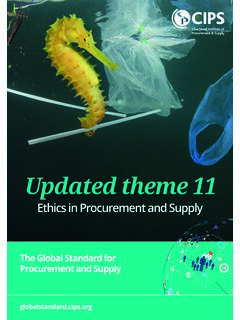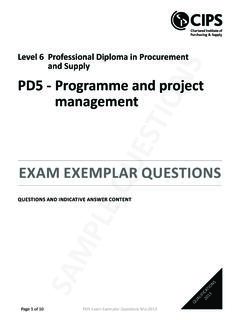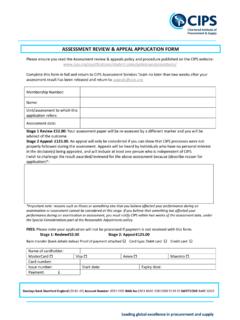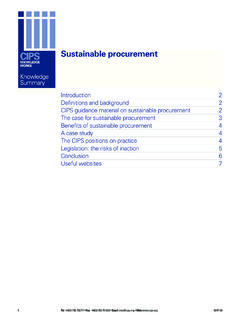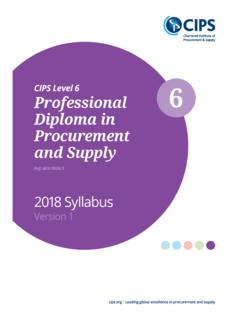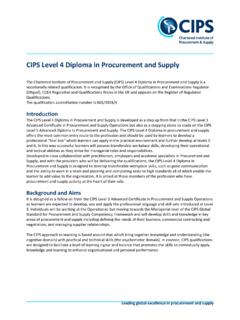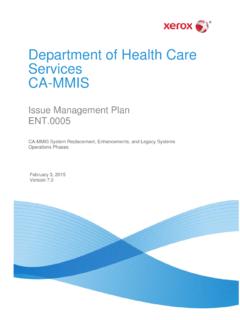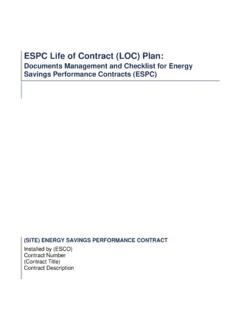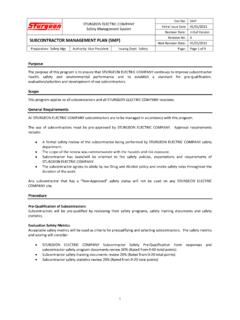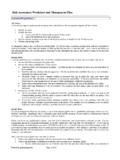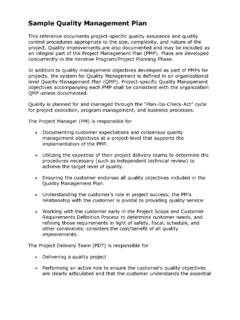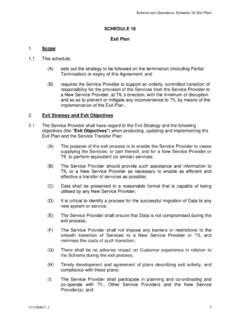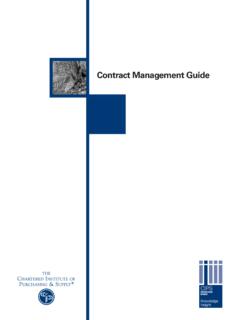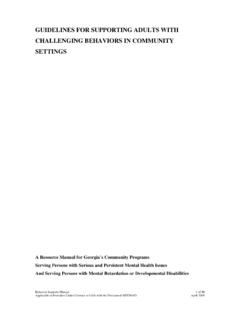Transcription of Category Planning Process - CIPS
1 Category Planning ProcessSA CIPSA Event David Andrews13thNovember 2013 ContentsContentsPage Category Planning Processes2 7 Effective Category Plans82 Copyright Capgemini 2013. All Rights ReservedCategory Planning Process | 13 Nov 2013 Effective Category Plans8 Strategy Communication - 22 Category Planning Process / 13 Nov 2013 Copyright (C) Capgemini 2013. All Rights Reserved. Procurement Process MapCategory Planning should be aligned with business objectives and developed with key customer stakeholders3 Copyright Capgemini 2013. All Rights ReservedCategory Planning Process | 13 Nov 2013 Category Plans should influence sourcing strategies & contract management of Category Planning ProcessPURPOSE: The Category Planning Process is used to develop Category plans that are aligned to Customers business objectives with a strategic approach to maximise value, reduce risk and effectively manage the supply of goods and/or : The Category Planning Process is used to develop Category plans that are aligned to Customers business objectives with a strategic approach to maximise value, reduce risk and effectively manage the supply of goods and/or ALIGNMENTA lignment with Customer business plans, procurement targets and customer stakeholder strategiesBUSINESS ALIGNMENTA lignment with Customer business plans, procurement targets and customer stakeholder strategiesCATEGORY plan Category plan 4 Copyright Capgemini 2013.
2 All Rights ReservedCategory Planning Process | 13 Nov 2013 Category DIAGNOSTICSCATEGORY DIAGNOSTICSCATEGORY plan DEVELOPMENTCATEGORY plan DEVELOPMENTCATEGORY MANAGEMENTCATEGORY MANAGEMENTOBJECTIVES FOR EACH KEY STEP OF THE Category Planning PROCESSOBJECTIVES FOR EACH KEY STEP OF THE Category Planning PROCESSA nalysis of current situation and market research to develop Category stakeholder engagement to jointly develop Category strategy and objectivesExecution of sourcing and contract management initiatives in alignment with Category Planning Process : Category Implement Category strategy / planSTEP 6 Category ManagementSTEP 6 Category ManagementCATEGORY PLANNINGCATEGORY Finalise Category plan using template and communicate to Profile the Current State ie; contracts; improvement Assess / confirm current business environment and Category plan DEVELOPMENTSTEP 4 Set Category DirectionSTEP 4 Set Category DirectionCATEGORY DIAGNOSTICSCATEGORY DIAGNOSTICSSTEP 2 Undertake Market Research / IntelligenceSTEP 2 Undertake Market Research / IntelligenceSTEP 5 Develop Category plan Monitor Performance STEP 5 Develop Category plan Monitor Performance Develop Supplier Profile(a)Define current supplier base (key characteristics; size; Describe the Category :(a) Category Definition(b)Scope (items / commodities / BSL STEP 3 Define Current StateSTEP 3 Define Current StateSTEP 1 Develop Category ProfileSTEP 1 Develop Category ProfileBUSINESS ALIGNEDC ategory Planning / management must align to Business; Customer and Procurement strategy, goals and ALIGNEDC ategory Planning / management must align to Business.))
3 Customer and Procurement strategy, goals and Manage supply / Manage Manage Manage Manage savings / compliance / customer Communicate the plan using Category Comms Track / report performance at Category Revise plan as required (or at least annually) to fit with current business priorities / Category ; issues; supply chain Review recent / ongoing projects and analyse the impact / results achieved for the business. Category Risk Assessment (note key risks for demand / supply / cost / market. Review opportunities previously / newly identified through Category diagnostics and perform initial value / ease Understand customer / stakeholder goals & objectives and identify gaps from current Develop / reconfirm Category Determine Category Perform idea / opportunity generation and impact / ease Prioritise and determine key activities (Short / Medium / Long term).. contract HANDVER COMPLETE characteristics; size; capacity; performance; risks); why we chose these suppliers.
4 (b)Define potential supplier pool(c)Define supplier risks(d)Determine supplier base Develop Market Profile (Market overview, demand / supply situation / market drivers / growth / trends / competitive environment / future outlook / risks ie raw mats availability / opportunities). Profile Category from BSL and supplier SP-PROM commodities / BSL businesses included)(c)Use / Process Develop Spend Profile to provide complete picture of spend for the Develop Demand Profile outlining BSL business need / future forecast / internal quality requirements that impact Develop Cost Profile. Analyse the total cost and the cost drivers that determine the cost of Category / sub- Category Develop Stakeholder PLANS REVIEWED PERIODICALLY Framework of Strategic Sourcing Refresh and Validate Diagnostics (egTotal Cost Model) Determine Initial Sourcing Detailed Project Develop Negotiation Conduct Negotiations and Develop Term Prepare and Develop New Develop Develop Commodity Profile Market Analysis (Identify Industry Leading Practices) Spend Analysis Product Scope Key Develop Evaluation Criteria (Kepner Tregoe Decision Analysis) Conduct Risk Assessments (incl.
5 LAWWNS) Conduct RFx (prepare, issue, receive) Execute New Agreement (signed by DOA) Finalise Implementation plan Develop and Execute Communication Establish Hold Kick-off Meeting Finalise Task Brief Conduct Establish and Test Hypotheses Generate Hypotheses / Task Brief Project Title Purpose & Objective Scope Deliverables Issues & Opportunities Key Steps / MilestonesENGAGEMENTDIAGNOSTICSPHASE 2 Develop Initial StrategyPHASE 2 Develop Initial StrategyPHASE 1 Validate OpportunityPHASE 1 Validate OpportunityPHASE 0 CreatePHASE 0 CreatePHASE 3 Approach MarketPHASE 3 Approach MarketPHASE 4 Execute StrategyPHASE 4 Execute StrategyPHASE 5 ImplementationPHASE 5 ImplementationIMPLEMENTSOURCING PLANSOURCING Portfolio Optimisation & Constraint Analysis Identify Strategic Impact & Cost Review Prioritised projects Compare Multiple Portfolio ScenariosPMOS electPMOS electCategory PlansCategory Plans6 Copyright Capgemini 2013. All Rights ReservedCategory Planning Process | 13 Nov Identify Resource Requirements / Internal Change management Recommend/ Syndicate Initial Develop Implementation / Change management Develop Stakeholder Briefing Obtain Stakeholders Finalise Agreement Total Cost Model Strategic Portfolio (Supply Positioning/ Supplier Preference) Determine Potential Generate Initial Hypotheses / Options / Ideas Opportunity Triangleissue, receive) Evaluate Responses (initial KT-DA) Conduct Supplier Interview / Assess Supplier Capability (Financials, Dun & Bradstreet, Reference Checks) Complete Supplier Finalise Decision Analysis and Rank Develop & Syndicate Implement Update Master Data (VDS, CMS, ERP) Conduct/ Complete Project Manage suppliers as per Supplier Schedule Post Implementation Review (6/12 months)
6 Hypotheses / Options / Ideas Conduct Analysis to Test Hypotheses Assess Supplier Capability (Screen Suppliers) Determine Conducting EOI / RFI Rank / Prioritise Hypothesis per Impact and EaseMilestones Team Customers Stakeholders Sites included Spend per Site / Total Spend Estimate Value Impact / Urgency Value Category Value DurationPMOPROJECT ENDORSEDT1 INITIAL STRATEGY ENDORSEDT2 FINAL STRATEGY APPROVEDT3T4 CLOSET5 LINE MANAGERAPPROVED Select Optimal Scenario Maximise Resource Utilisation and Capacity Planning Projects Selected or Unselected Analyse Skill GapsT0 PROJECTSELECTEDAPPROVAL TO Ensure legal approval for ontract contract management to Ensure legal approval for contract variations of any Update CMS for contract addendums and variations. contract management to include sustainable supply chain management : Safety management system Environment contract management Confirm P2P/ERP systems active to support the contract design. Update Master Data ( ERP, P2P, Vendor Master) Payment Ensure master Check Contractor Safety management System requirements for the contract are Prepare Stakeholder Prepare supplier transition/ implementation Develop and Set-up the contract in the contract management System (CMS).
7 Upload all key documents ( contract approvals, executed contract ). Upload contract master data (key contract dates, contract SET-UPSTEP 2 Set-Up CMSSTEP 2 Set-Up CMSCONTRACT HANDOVERCONTRACT Setup contract renewal in Lifecycle Complete contract Handover contract documents contract approval briefing paper Executed Other Sourcing documentation STEP 1 contract HandoverSTEP 1 contract Execute New Agreement Finalise Implementation plan Develop and Execute Communication Implement Update Master Data (VDS, CMS, ERP) STEP 3 Set-Up P2 PSTEP 3 Set-Up P2 PSourcing Process ImplementationSourcing Process ImplementationSTEP 4 Supplier Relationship ManagementSTEP 4 Supplier Relationship Finalise delivery to Implementation Determine Supplier Preferencing using the Krajlic Portfolio Matrix assessment Manage suppliers as per Supplier Review Monitor market and Maintain documentation and document Complete Environmental Document and track product or service non conformances.)
8 SCAPAR system Process 5 contract GovernanceSTEP 5 contract GovernanceCONTRACT MANAGEMENTC ategory PlansCategory Plans7 Copyright Capgemini 2013. All Rights ReservedCategory Planning Process | 13 Nov Environment management System Waste minimization Product stewardship Product Lifecycle Assessment LAWWNS Check insurances are upto Conduct contract analysis for decision point for contract renewal in Lifecycle project see Step at least 6 months prior to contract is Develop and execute communication Ensure Risk Assessments are done Supplier and contract Risk dates, Category , internal business alignment) Update contract financials (spend, budget, supplier profile) Stakeholders and contacts updated in CMS (supplier, internal customers, key stakeholders eg legal).END OF SOURCING Process documentation Commodity Category Sourcing Supplier Safety Risk Implementation / Change management plan preparedT5 ERP) Conduct/ Complete Project Manage suppliers as per Supplier Schedule Post Implementation Review (6/12 months) contract HANDOVER COMPLETET6 contract COMMENCEDATET7supplier Create and keep a correspondence Monitor KPI Track spend, budget and audit Ensure systems are upto date and guidelines followed Price variations Manage contract initiatives using the Lifecycle Conduct Post Implementation Reviews for Initiatives in place (6/12 months) contract EXPIRYT9 contract RENEWALT8 contract Governance Step is iterative for the life of the of the Sourcing StepsEffective Category PlansCategory Plans should be developed with key stakeholders and: align with customer business objectives; influence scope of Category sourcing projects & strategies;8 Copyright Capgemini 2013.
9 All Rights ReservedCategory Planning Process | 13 Nov 2013 provide strategic direction of contract management initiatives; require an effective Category Strategy communication : Category Plans must be reviewed and refreshed Capgemini 2012. All Rights ReservedTelecommunication Expense management | 2/11/2012 Example Category Strategy Office ProductsOffice Products - Category Strategy OverviewCategory Goals and VisionBusiness needs and PrioritiesImplement continuous improvement strategies to maximise cost savings and improve B2B automation System compatibility to maintain B2B efficiencies. Maximise cost saving opportunities. Effective supply of goods to all locations Provision of goods & services that are fit for purpose . Category StrategyOpportunitiesPromote sole supplier agreement to leverage spend and increase B2B automation for supply of office products and Grow contract by reducing escape spend. Increase e-Business/ B2B Capgemini 2013.
10 All Rights ReservedCategory Planning Process | 13 Nov 2013 ObjectivesKey Activities Year 1 Year 2 Year 3 Grow contract - reduce escape spendPromote value of new contract with StaplesPotential to add new acquisitions to existing compliance of contract across BusinessIncrease e-Business/B2B AutomationPromote improvement in policy & B2B ordering processesOn-going developmentDeliver savings from product substitutionEasy savings program (pop- up functionality) Product standardisation and rationalisation hard- coding of cheaper alternativesContinuous improvement Purchase Order Value rebateEnhance supplier reporting -performance/spend dashboardsRefresh Category profileand Category plan . increase B2B automation for supply of office products and stationery across all businesses. Increase e-Business/ B2B automation. Deliver savings from product substitution Implement continuous improvement strategiesCategory ScopeCategory Tree Category Definition The Stationery and office products Category consists of products regularly used in offices and consist of:-Core Products including General Stationery, office paper, printer consumables and office filing; and -Non Core Products including Janitorial, print and forms, canteen supplies and Breakdown of Category DescriptionBranchClassification INDIRECT MATERIALSS tationery Office Products11 Copyright Capgemini 2013.


